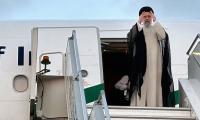Comment
LAHORE: It has been observed that in the past three transfers of power from elected governments to the caretakers, the state of economy that looked good then became highly vulnerable when the next elected regime took the helm.
It is because the newcomers have to cope with the core economic issues they had no choice but to inherit from their predecessors. This predominantly forces them to deviate from their original agenda. When Shaukat Aziz, the former prime minister during erstwhile military dictator Pervez Musharraf’s regime, completed his tenure and handed over the government to caretakers, Pakistan was one of the fastest growing economies in the world. By the time the government was handed over to the elected government the economy was in shambles.
There was a foreign exchange crisis, inflation was ballooning. It took the elected government almost five years to put back the economy on growth path.
In the last year of Pakistan People’s Party (PPP) government the growth rate was 3.8 percent – a much improved growth rate than the 2-2.5 percent growth rate of first two years.
When the Pakistan Muslim League-Nawaz (PML-N) government assumed power in 2013 the economy was at the brink of disaster. The country was facing balance of payment crisis and had to go to International Monetary Fund (IMF) for assistance.
The economic policies of this government were appreciated by international donor agencies as the growth rate touched respectable 5.8 percent of the GDP in its last year. Things started changing sharply immediately after the interim government assumed power. We are again facing balance of payment crisis. Experts say the next government would have to go back to the IMF for assistance.
If that happens then the next regime would become the third consecutive elected government to be forced to seek the IMF loans on hard terms.
The IMF loans carry harsh terms because it is the lender of the last resort.
The caretakers have no stakes in the elections. They cannot take major policy decisions but are at liberty to adjust the petroleum products rates, give green signal to the central bank to let rupee find its own market value, raise the electricity tariff, etc. It cannot increase tax rates or levy new taxes.
However, compared to the impact of weak rupee and higher rates of petroleum and electricity, the effect of higher taxation is less on the general public.
Generally the caretaker finance ministers are highly reputed professionals. They know the impact of their decisions.
They may be taking right decisions but they do not have the time to implement them.
The next elected government mostly comprises politicians and they are likely to panic on short-term outcomes of caretakers’ decisions. There is likelihood that they may not be able to handle the situation prudently and further depress the economy.
The entire behavior of the economy changes when these avenues are disturbed.
The power rates this time around are stable but higher petroleum rates and constantly declining rupee has certainly created high inflationary pressure as price of every item is moving up. High transportation cost of agricultural produce impacts fruits and vegetable rates. Lower rupee value increases the cost of inputs used by domestic industries.
Imports become costlier. The rupee has shed over 15 percent against the US dollar in one month.
That means all imports would become much costlier after taking into account the impact of import duties and the 16-17 percent sales tax paid on duty-paid values. Simply put an item worth Rs104 (one dollar) a month back with import duty of ten percent used to cost an importer Rs132.70 after paying sales tax of 16 percent on duty-paid value of Rs114.40.
Now the same item worth one dollar has to be imported at Rs122 and its cost would shoot up to Rs155.30. The impact would look much sharper on an item worth $100 when the price will increase from Rs13370 to Rs15530. – a difference of 2160.
The price for an item worth 1000 dollars would increase by Rs21,600.
A representational image showing an oil refinery. — AFP/FileKARACHI: Pakistan Petroleum Limited has announced a...
P@SHA Chairman Zohaib Khan was the esteemed Chief Guest at Aptech 2023. — X/PASHAORG/FileKARACHI: Muhammad Zohaib...
PSX marked the listing of the Mahaana Islamic Index Exchange Traded Fund with a gong ceremony on April 23, 2024. —...
FPCCI Regional Chairman and VP Zaki Aijaz while speaking during a round table discussion on the challenges and...
This representational image shows Gold bars. — AFP/FileKARACHI: Gold prices in the local market fell by Rs7,800 per...
Security personnel walk past the US Federal Reserve building in Washington, DC on Oct 22, 2021. — AFPNew York:...







